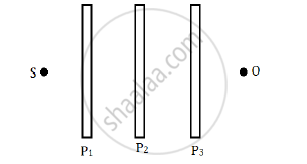Advertisements
Advertisements
प्रश्न
Show, using a simple polaroid, that light waves are transverse in nature. Intensity of light coming out of a polaroid does not change irrespective of the orientation of the pass axis of the polaroid. Explain why.
उत्तर
To show light waves are transverse in nature:
Take two polaroids T1 and T2 cut with their faces parallel to the axis of the crystal

When polaroid T1 is rotated about the direction of the propagation of light as axis, the intensity of the transmitted light remains the same. When T2 is rotated gradually, the intensity goes on decreasing and the transmitted light disappears completely when T2 is perpendicular to T1.
This happens because the polaroid allows only those vibrations of light which are parallel to its axis. This is true only if light has vibrations in all possible directions and hence is a transverse wave.
Light waves are transverse waves. So, they have electric vectors in all possible directions. When a polaroid is placed in between the path of the light, the electric vectors which are parallel to the pass-axis of the polaroid pass through it. Even if the polaroid is rotated, there would be other electric vectors which pass through it. So, the intensity of light does not change irrespective of the orientation of pass-axis of the polaroid.
APPEARS IN
संबंधित प्रश्न
Three identical polaroid sheets P1, P2 and P3 are oriented so that the pass axis of P2 and P3 are inclined at angles of 60° and 90° respectively with the pass axis of P1. A monochromatic source S of unpolarised light of intensity I0 is kept in front of the polaroid sheet P1 as shown in the figure. Determine the intensities of light as observed by the observer at O, when polaroid P3 is rotated with respect to P2 at angles θ = 30° and 60°.

Find an expression for intensity of transmitted light when a polaroid sheet is rotated between two crossed polaroids. In which position of the polaroid sheet will the transmitted intensity be maximum?
How does one demonstrate, using a suitable diagram, that unpolarised light when passed through a Polaroid gets polarised?
Using the phenomenon of polarisation, show how the transverse nature of light can be demonstrated.
What is the Brewster angle for air to glass transition? (Refractive index of glass = 1.5)
Unpolarised light is passed through a polaroid P1. When this polarised beam passes through another polaroid P2 and if the pass axis of P2 makes angle θ with the pass axis of P1, then write the expression for the polarised beam passing through P2. Draw a plot showing the variation of intensity when θ varies from 0 to 2π.
What is the value of refractive index of a medium of polarising angle 60°?
With the help of an experiment, state how will you identify whether a given beam of light is polarised or unpolarized?
State any two methods by which ordinary light can be polarised
Discuss about pile of plates.
